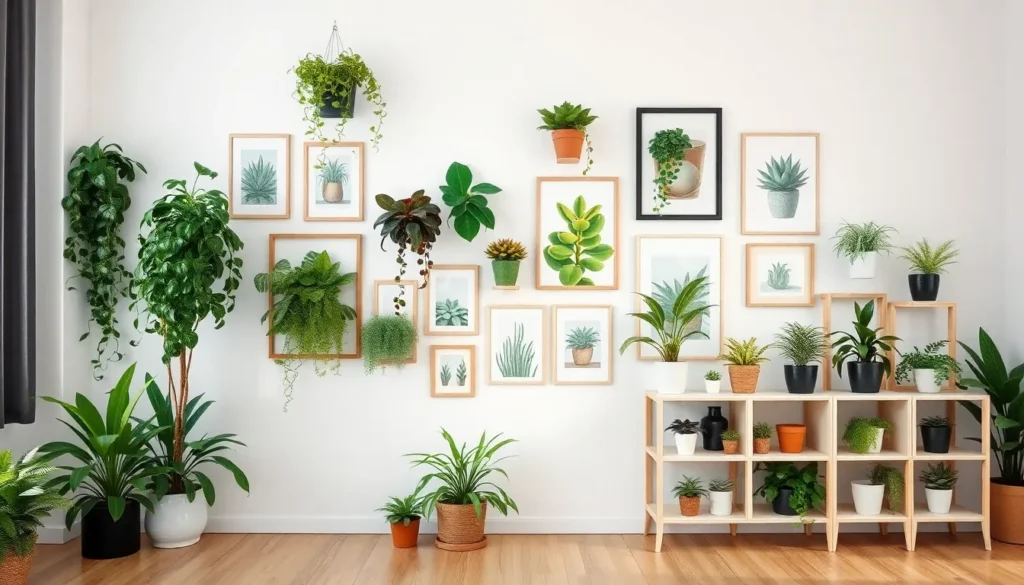We’ve all seen those stunning gallery walls that make us stop scrolling and wonder how they achieved such perfect balance. But what if we told you there’s a secret ingredient that transforms any ordinary wall display into a living masterpiece? Plants.
Adding greenery to your gallery wall isn’t just trendy – it’s revolutionary. The combination of botanical elements with framed artwork creates depth, texture, and visual interest that flat displays simply can’t match. We’re talking about breathing life into your walls while showcasing your personal style.
Whether you’re working with a small apartment corner or a grand living room statement wall, incorporating plants into your gallery arrangement opens up endless creative possibilities. From trailing pothos that cascade between frames to sculptural succulents that anchor your composition, we’ll show you how to master this design trend that’s taking homes everywhere by storm.
Choose the Perfect Wall Space for Your Gallery Wall With Plants
Selecting the ideal wall location sets the foundation for your plant gallery wall success. We’ll explore key factors that determine where your botanical artwork display will thrive.
Consider Natural Light Requirements
Assess the sunlight patterns in your chosen space before committing to a gallery wall location. South facing walls receive the most intense light throughout the day, making them perfect for sun loving plants like succulents and cacti. East facing walls offer gentle morning light that works well for pothos, philodendrons, and most tropical houseplants.
Match your plant selections to the available light conditions rather than forcing shade loving plants into bright spots. North facing walls provide consistent low light ideal for snake plants, ZZ plants, and peace lilies. West facing walls get afternoon sun that can be too harsh for delicate foliage plants but perfect for trailing plants like string of hearts.
Monitor seasonal light changes that affect your wall space throughout the year. Windows may be partially blocked by trees in summer or receive more direct light in winter months. We recommend observing your chosen wall for at least a week to understand its light patterns before installing your gallery wall.
Evaluate Wall Size and Layout Options
Measure your wall dimensions carefully to plan the perfect scale for your plant gallery arrangement. Large walls spanning 8 to 12 feet work best for expansive gallery walls that combine multiple plant shelves with artwork. Smaller walls between 4 to 6 feet suit intimate displays featuring 3 to 5 key pieces.
Plan your vertical spacing to accommodate both hanging plants and wall mounted planters without overcrowding. We suggest leaving 12 to 18 inches between each row of elements to allow trailing plants room to cascade. Ceiling height impacts your design options, with 9 foot ceilings or higher allowing for dramatic hanging plant displays.
Consider furniture placement below your gallery wall that might interfere with plant care or growth. Sofas, tables, and other furniture should be positioned at least 2 feet away from hanging plants to prevent leaf damage. Wall mounted plant shelves need clear access for watering and maintenance.
Account for Humidity and Temperature Factors
Check your room’s humidity levels since most houseplants thrive in 40 to 60 percent humidity. Bathrooms and kitchens naturally provide higher humidity that benefits tropical plants like ferns and orchids. Living rooms and bedrooms typically have lower humidity requiring plants that tolerate drier conditions.
Avoid temperature extremes near heating vents, air conditioning units, and drafty windows that stress plants. Consistent temperatures between 65 to 75 degrees Fahrenheit support healthy plant growth in gallery wall displays. Cold drafts from windows can cause leaf drop in sensitive plants like fiddle leaf figs.
Monitor air circulation around your gallery wall to prevent fungal issues and promote healthy plant growth. Stagnant air encourages pest problems and disease, while gentle air movement strengthens plant stems. We recommend using a small fan on low speed if your chosen wall lacks natural airflow.
Select the Right Mix of Plants for Your Gallery Wall
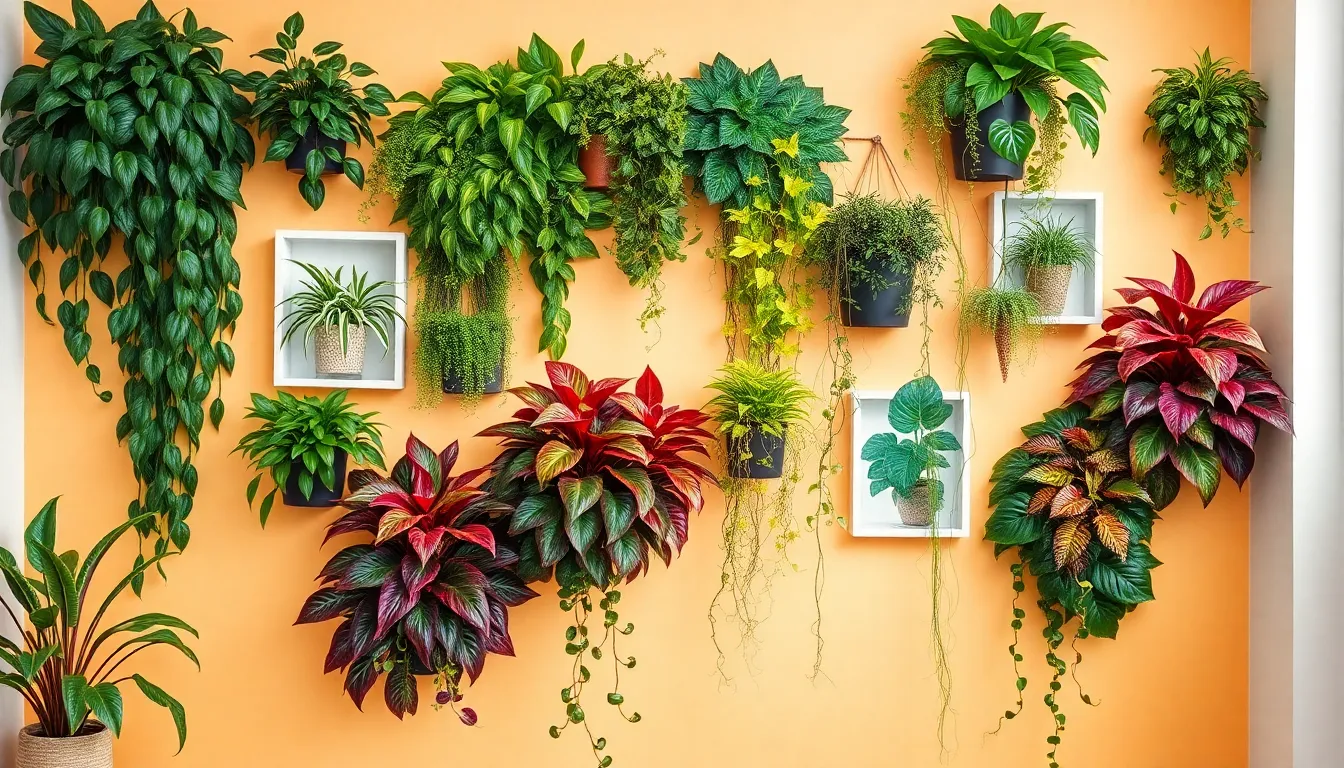
Now that we’ve established the perfect spot for our gallery wall, it’s time to curate the ideal plant collection that’ll thrive together in harmony.
Incorporate Low-Light Tolerant Varieties
Pothos and philodendrons stand out as our top choices for areas with minimal sunlight, adapting beautifully to indoor conditions while maintaining their lush appearance. These hardy plants tolerate low light environments and provide the reliability we need for consistent gallery wall success.
Moss creates an excellent foundation element that requires little to no direct light, filling gaps between other displays while maintaining that verdant backdrop we’re after. Air plants offer another maintenance-free option that’ll keep our wall looking full without demanding bright conditions.
Preserved houseplants deliver the visual impact we want without any light requirements at all, making them perfect for filling challenging spots where live plants might struggle. We can strategically place these throughout our gallery wall to ensure every corner stays vibrant.
Balance Trailing and Upright Plant Forms
Trailing varieties like pothos and philodendrons add that coveted softness as their vines cascade gracefully down our gallery wall shelves, creating natural movement that draws the eye. Popular options include Pearls & Jade pothos, Marble Queen, and Golden Pothos, each offering unique variegation patterns.
Upright plants provide the structural backbone our gallery wall needs, with compact bushy types offering contrast against flowing vine arrangements. Philodendrons like lemon-lime and Philo Brasil work beautifully as upright specimens before they begin trailing.
Scindapsus Pictus brings textural interest with its silvery markings, often mistaken for satin pothos but offering its own distinct personality to our plant mix. Combining these different growth forms creates ever-changing layers that keep our gallery wall visually captivating from every angle.
Consider Seasonal Color Changes
Hoyas reward us with both luscious foliage and seasonal flowers, adding natural rhythm to our gallery wall as they bloom throughout different times of the year. These plants shift their appearance seasonally, ensuring our display never looks static.
Certain philodendrons change foliage color as seasons progress, providing built-in variety that keeps our gallery wall fresh without requiring plant swaps. We’ll notice subtle shifts in hue and intensity that mirror nature’s own seasonal transitions.
Selecting plants with varied foliage colors and textures ensures year-round visual interest, with some specimens offering burgundy undertones in cooler months while others maintain bright greens. This natural color evolution means our gallery wall stays vibrant throughout every season without additional effort from us.
Design Your Gallery Wall Layout With Plants
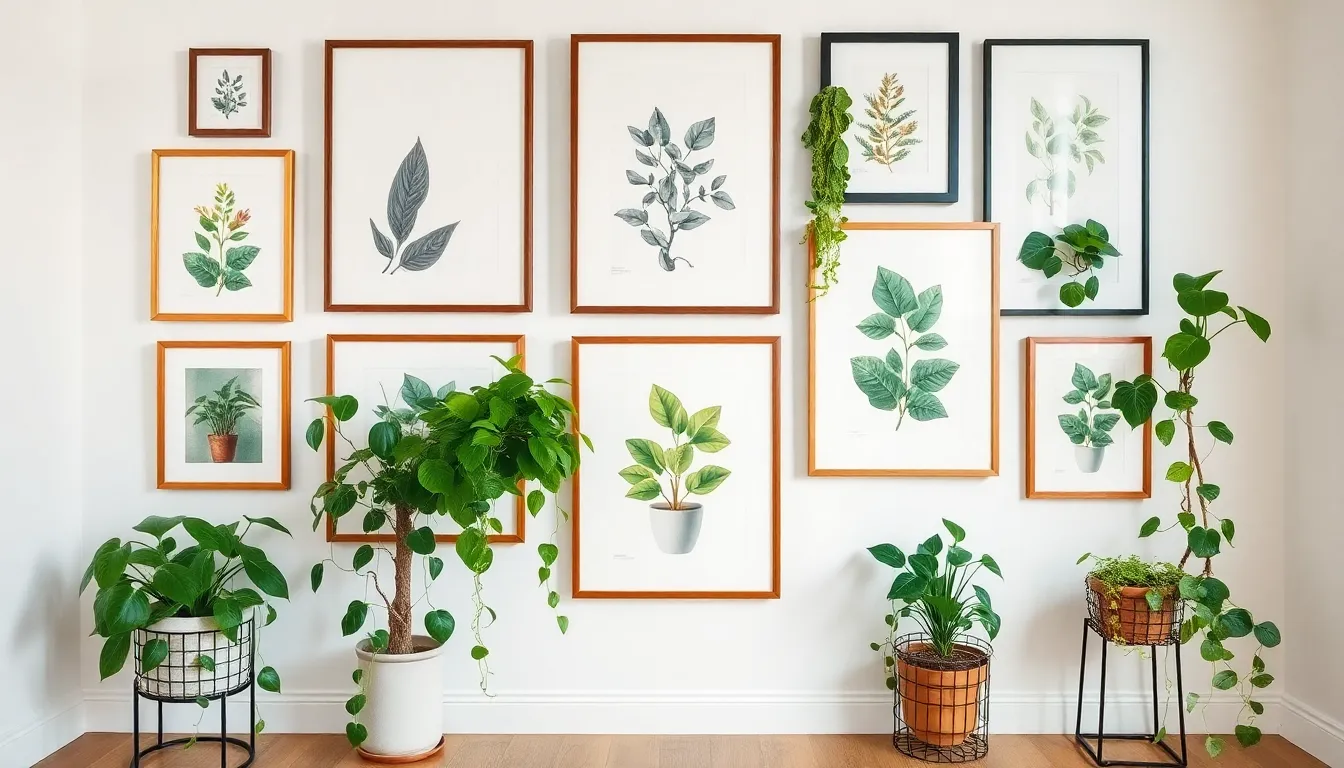
Now that we’ve selected our perfect plant mix, it’s time to arrange everything into a cohesive design. Creating a successful layout requires strategic placement that considers both visual appeal and practical plant care needs.
Create Visual Balance With Symmetrical Arrangements
Symmetrical layouts offer a calming, structured appearance that works beautifully in formal or minimalist interiors. We recommend arranging plant frames and planters evenly across your wall space to create perfect harmony. Start by placing your largest statement piece in the center, then mirror smaller elements on both sides.
Botanical gallery walls benefit from incorporating shelves with potted plants mixed alongside framed art prints for added texture and depth. We suggest using matching planters or frames in similar colors to maintain the symmetrical flow. This approach creates a gallery wall that feels intentional and polished while showcasing your plant collection effectively.
Consider grouping plants with similar care requirements on each side of your symmetrical design. This strategy makes maintenance easier while preserving the balanced aesthetic we’re aiming for.
Use the Rule of Thirds for Asymmetrical Designs
Asymmetrical designs create ever-changing visual interest by strategically distributing elements across your wall space. We divide our wall into three sections using the rule of thirds, then place plant mounted frames and decorative elements unevenly but thoughtfully within those sections.
Combine different sizes of plants, frames, and planters to add variety while maintaining overall composition balance. We recommend placing your heaviest visual element in one third of the space, then balancing it with smaller grouped items in another section. This technique prevents your gallery wall from feeling cluttered or chaotic.
Empty frames housing wall mounted planters offer a creative twist that works exceptionally well in asymmetrical arrangements. We can use these alongside traditional framed botanical prints to create layers and visual flow throughout the design.
Plan for Plant Growth and Maintenance Access
Smart planning for plant growth ensures our gallery wall remains beautiful and functional over time. We need to consider each plant’s growth habits and leave sufficient space around planters for natural expansion and easy maintenance access.
Choose appropriate plants based on your wall’s light availability throughout the day. Low maintenance species like pothos, spider plants, or English ivy work perfectly for beginners or areas with limited natural light. These varieties adapt well to wall mounted conditions and require minimal daily attention.
Water access becomes crucial for long term success, so we position plants where we can easily reach them for watering and pruning. Propagation walls or wall mounted propagation tubes add fresh growth potential and visual appeal to our design. We regularly change water in propagation tubes and ensure all plants receive proper light exposure to maintain a thriving display.
Wire baskets lined with plastic sheeting create excellent wall planters for trailing plants while maintaining that rustic aesthetic we love. This approach works especially well for ivy or pothos that naturally cascade downward, adding movement and life to our gallery wall arrangement.
Choose Appropriate Hanging Systems for Your Plant Gallery Wall
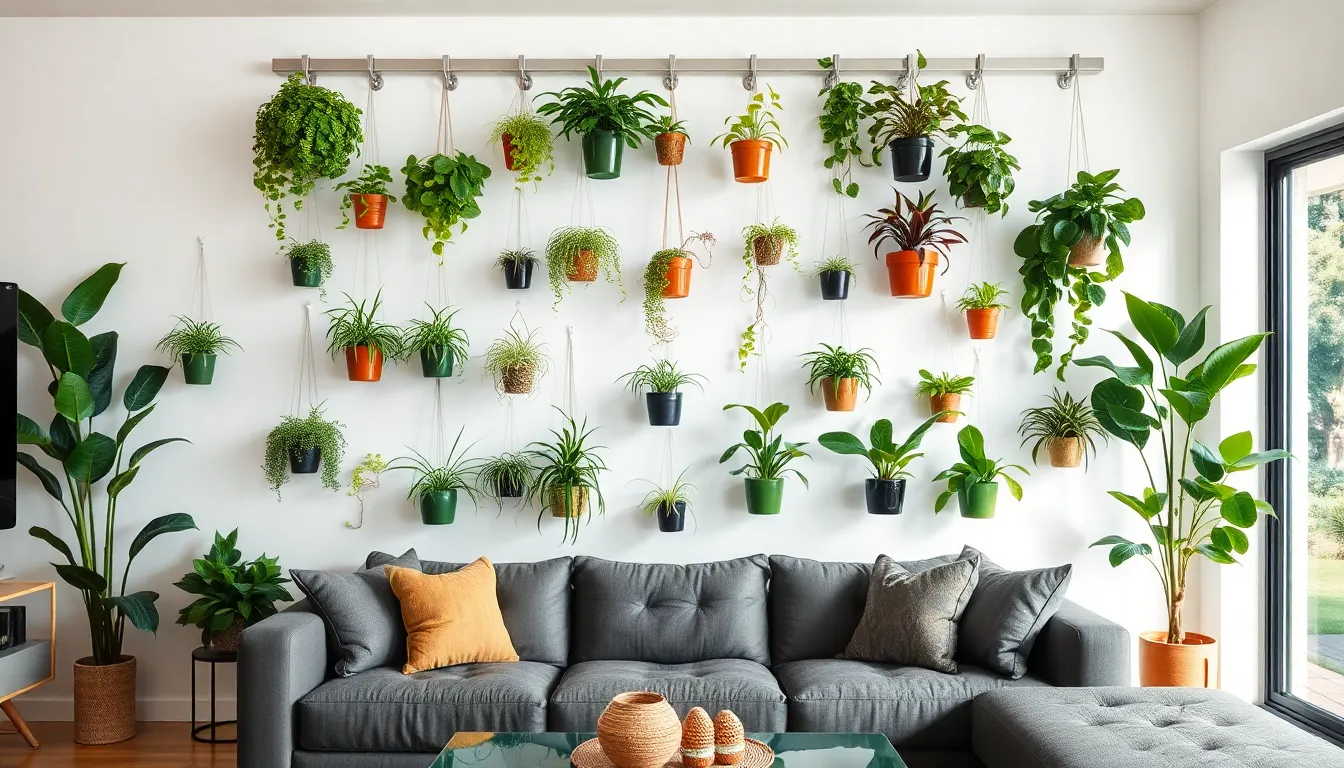
Picture hanging systems offer the most versatile solution for creating ever-changing plant gallery walls. These aluminum rail systems paired with nylon or stainless steel cords let us easily reposition plants without damaging walls or reinstalling hardware.
Install Sturdy Wall Anchors and Brackets
Sturdy installation becomes critical when we’re supporting plants that can weigh significantly more than traditional artwork. Picture hanging system rails must be secured directly into studs or with heavy-duty wall anchors rated for the full expected weight. Each hook in professional systems like the Artiteq Twister can support up to 20 kg when properly installed, giving us confidence in our plant displays.
We need to choose appropriate hardware based on our wall material, whether it’s drywall, concrete, or brick. Aluminum rails distribute weight more effectively than individual hooks, reducing stress on any single mounting point. This approach prevents wall damage while ensuring our plants stay securely in place.
Select Adjustable Hanging Hardware
Adjustable hardware transforms our plant gallery into a flexible living display that evolves with our plants’ growth. Grip hooks that slide along hanging wires and lock into position let us modify heights without tools or wall damage. The Artiteq system’s transparent nylon wires with metal heads slide smoothly in rail grooves, making repositioning effortless.
We can easily accommodate plants of varying sizes by adjusting individual hanging heights. Manual grip hooks offer precise control, while automatic versions provide quick adjustments for frequent rearrangements. This flexibility means we’re not locked into our initial design as plants mature or seasons change.
Consider Weight Distribution Across the Wall
Weight distribution prevents system failure and protects our walls from damage over time. We should space hanging points evenly rather than clustering heavy plants in one area. Plants closest to wall studs can carry more weight safely, while lighter specimens work well between studs with appropriate anchors.
Multiple hanging points for heavier plants distribute the load more effectively than single-point suspension. Combining ceiling-mounted and wall-mounted systems creates additional support options for substantial plant collections. We can also alternate plant weights along our rail system, balancing heavier specimens with lighter air plants or preserved arrangements.
Incorporate Artwork and Decorative Elements
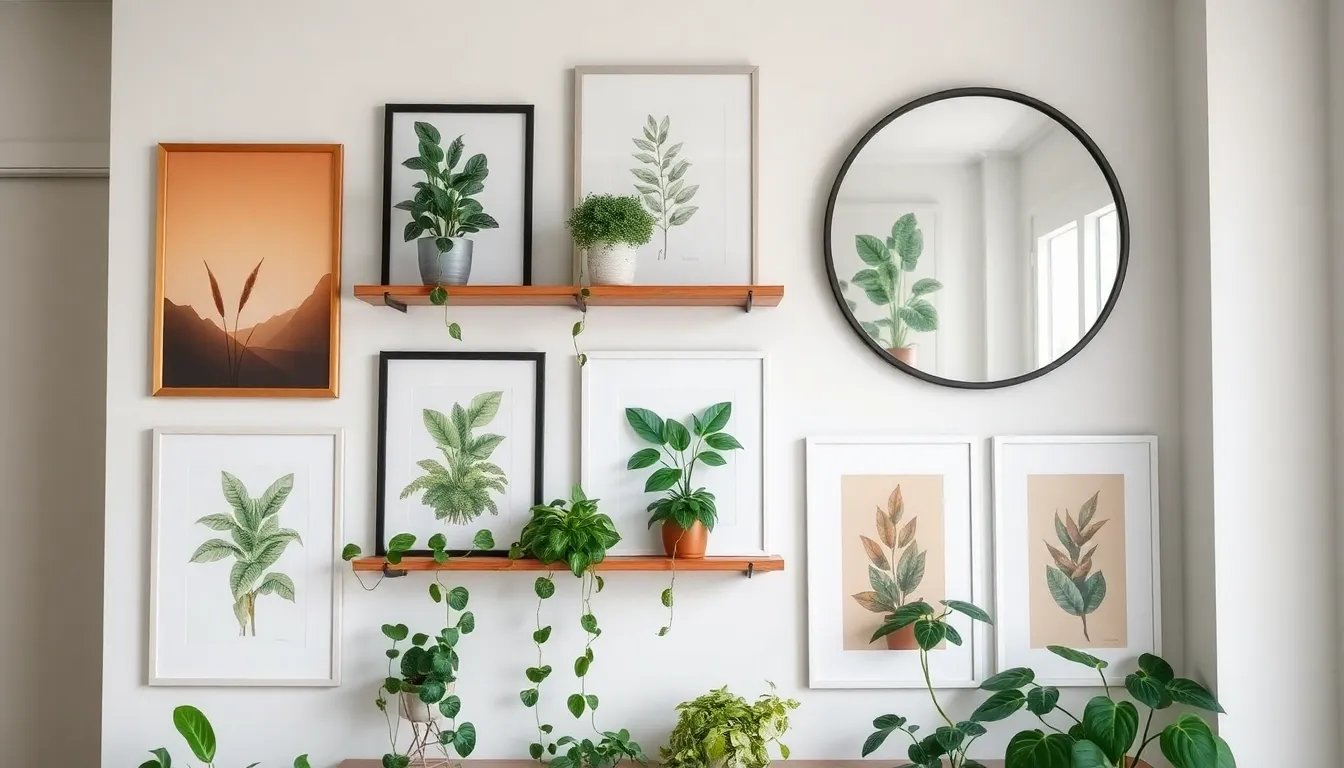
Blending framed art with live plants creates stunning visual contrast between structured lines and organic forms. This combination offers the perfect balance of warmth and sophistication to transform any wall space.
Mix Botanical Prints With Live Plants
Combining framed botanical prints with real plants on shelves or wall mounts brings freshness and texture while echoing nature’s beauty indoors. We love how this approach creates a layered, curated look that feels both intentional and organic. Shelves provide an excellent way to display multiple potted plants alongside framed prints, allowing us to showcase trailing pothos vines or preserved eucaleus for low-maintenance decor.
Artwork with warm tones like orange pairs beautifully with foliage or pots featuring complementary colors. Varying the heights of frames and plant displays adds dimension and interest to our arrangement. We recommend choosing botanical prints that echo the colors and shapes of our living plants to create visual harmony throughout the display.
Add Mirrors to Enhance Light Reflection
Mirrors incorporated into our gallery wall help amplify natural light, making the space brighter and feel larger. Positioning mirrors near plants increases the reflection of greenery, improving the overall sense of vibrancy and airiness in the room. We find that strategically placed mirrors can double the visual impact of our plant collection by creating beautiful reflections.
Circular mirrors work particularly well with trailing plants, while rectangular mirrors complement upright plant forms. The added light reflection also benefits our plants’ health by providing additional illumination from multiple angles.
Include Shelving for Additional Plant Display
Shelving serves as both practical and decorative elements, allowing us to showcase a variety of plants at different heights alongside framed art. This creates a ever-changing gallery wall where plants can be mixed with decorative objects and photos, enriching the depth and texture of our display. Floating shelves maintain clean lines while providing sturdy support for potted plants.
We appreciate how shelves make plant care more convenient by allowing easy access for watering and maintenance. Multiple shelf levels create opportunities to display plants with different light requirements at appropriate heights. This approach also lets us rotate seasonal decorative elements while keeping our core plant collection intact.
Maintain Your Gallery Wall With Plants
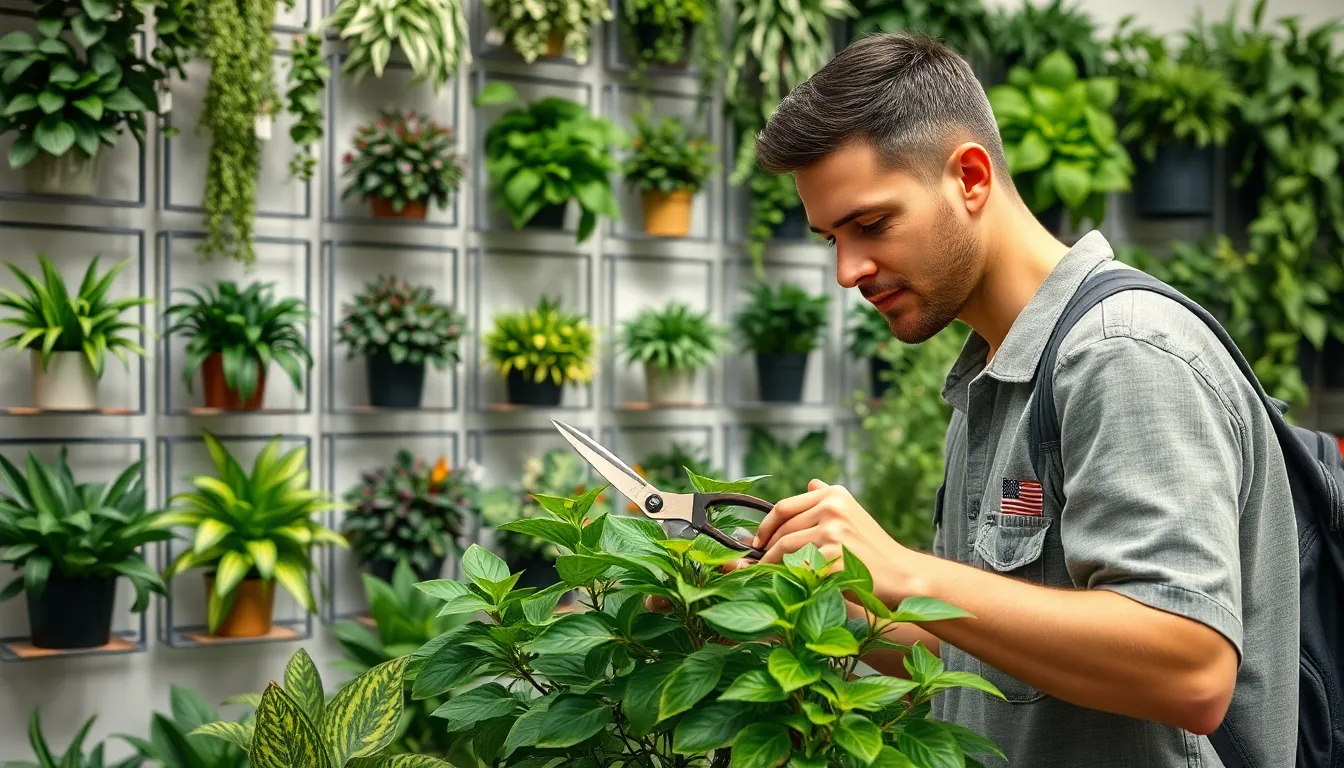
Keeping your plant gallery wall thriving requires consistent care and attention to detail. We’ll walk you through the essential maintenance practices that ensure your living wall display remains vibrant and healthy.
Establish a Regular Watering Schedule
Creating a consistent watering routine is the foundation of gallery wall plant care. We recommend checking soil moisture daily and adjusting your schedule based on your exact plant types and wall setup. Living walls with recirculating water systems typically need watering once daily, while drip irrigation systems may require multiple watering sessions to maintain even soil moisture throughout the display.
Seasonal adjustments keep your watering schedule effective year-round. During warmer months, we increase watering frequency as plants actively grow and lose more moisture through transpiration. Cooler seasons call for reduced watering since plant growth slows and soil retains moisture longer.
Watch for telltale signs of watering issues to fine-tune your routine. Brown leaf tips and wilting indicate under-watering, while yellowing leaves and musty soil odors suggest over-watering. We address these symptoms immediately by adjusting our watering frequency and checking drainage systems for proper function.
Monitor Plant Health and Growth Patterns
Daily observation helps us catch plant problems before they spread throughout the wall. We examine each plant for wilting, browning, unusual spots, or changes in leaf color that might indicate stress, disease, or pest issues. Early detection allows for quick treatment and prevents problems from affecting neighboring plants.
Weekly pruning and maintenance keep plants looking their best. We remove dead or brown leaves to maintain plant vigor and prevent decay that could harbor pests or disease. Pruning overgrown branches prevents larger plants from shading smaller ones below, ensuring all plants receive adequate light for healthy growth.
Strategic fertilization during growing seasons supports robust plant development. Spring and summer feeding boosts growth and flowering, whether applied manually or through automated irrigation systems. We monitor soil nutrient levels regularly to prevent deficiencies that could weaken plants and make them susceptible to problems.
Rotate Plants for Even Light Exposure
Rotating plants ensures uniform growth across your entire gallery wall. We move plants periodically so all sides receive balanced light exposure, preventing lopsided growth patterns that can create visual imbalances in our carefully designed display. This practice is especially important for walls that receive directional lighting from windows or fixtures.
Strategic repositioning prevents plant competition and shadowing issues. Taller or bushier plants naturally block light from reaching plants positioned below them. We regularly assess our wall arrangement and rotate plants to different positions, ensuring smaller or light-hungry varieties get their fair share of illumination.
Systematic rotation schedules help us track plant movements effectively. We rotate plants every two to three weeks, keeping notes on which plants perform best in exact wall positions. This approach helps us identify the ideal permanent locations for each plant type while maintaining overall wall health and visual appeal.
Style Your Gallery Wall With Plants for Different Rooms
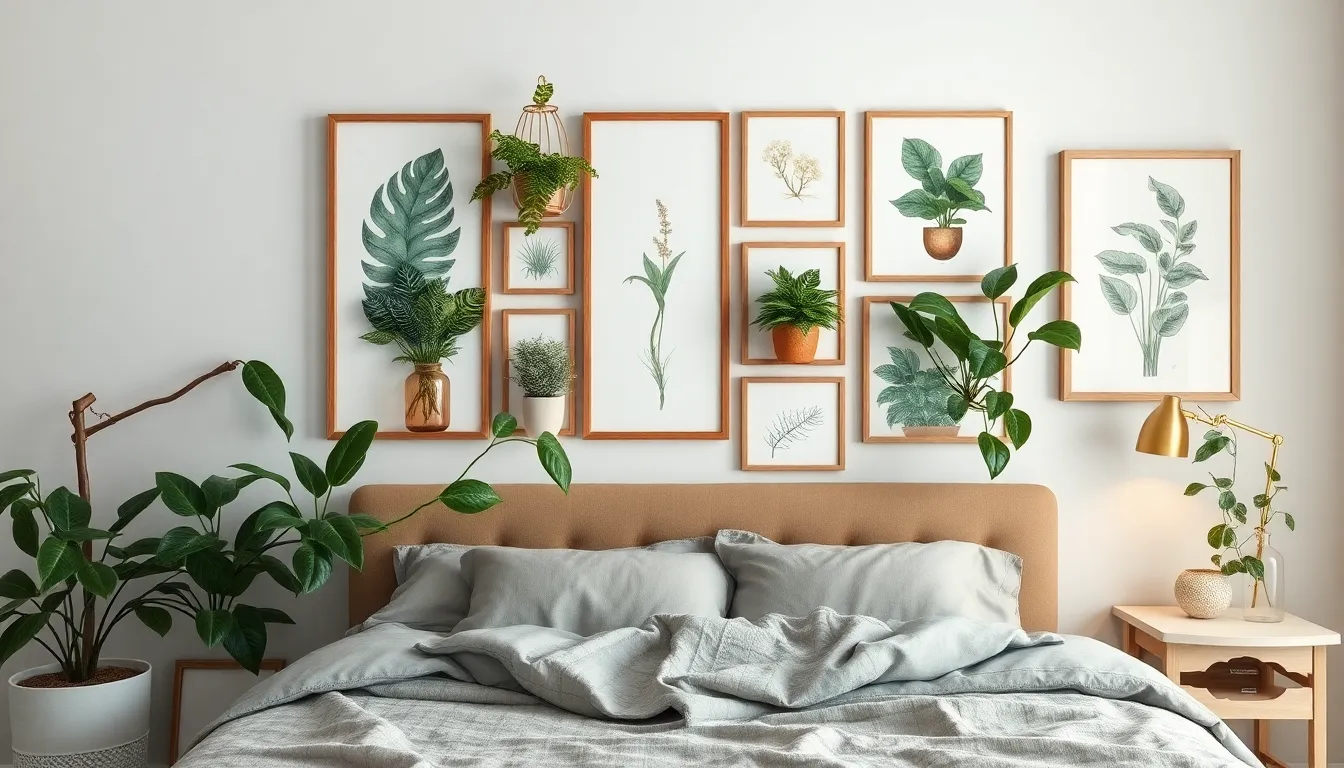
We’ll explore how to customize your plant gallery wall to complement each room’s unique purpose and atmosphere. Different spaces call for different plant choices and styling approaches.
Create a Calming Bedroom Plant Gallery
Bedroom galleries work best with plants that promote relaxation and thrive in lower light conditions. Small to medium-sized plants like pothos and snake plants create the perfect foundation for a peaceful display. We recommend combining wall-mounted planters with framed botanical prints or empty painted frames to establish a cohesive botanical theme.
Soft color palettes enhance the calming effect of bedroom plant galleries. Natural wood frames and gold accents complement the serene atmosphere while maintaining visual interest. These materials work particularly well with the gentle textures of bedroom-friendly plants.
Consider the restorative qualities of your plant selection. Plants naturally boost serenity in personal spaces by bringing outdoor elements indoors. The gentle presence of greenery creates a soothing environment that supports better rest and relaxation.
Design a Vibrant Living Room Display
Living rooms offer the perfect opportunity for more diverse and colorful plant gallery walls. Mix floating shelves with potted plants of various sizes and textures to create ever-changing visual layers. We suggest incorporating spider plants and English ivy for their lively growth patterns that add movement to the display.
Air plants in decorative hanging holders bring unique sculptural elements to living room galleries. Wire baskets and creative containers work exceptionally well for these low-maintenance options. They add vertical interest without requiring traditional soil-based planters.
Bold frame colors and metallic finishes make living room plant galleries true focal points. Painted frames in vibrant hues or metallic tones surrounding wall planters create eye-catching contrasts. This approach transforms your plant display into natural art that brightens the entire space.
Arrange a Functional Kitchen Herb Wall
Kitchen plant galleries serve dual purposes by combining decoration with practical herb cultivation. Construct vertical herb gardens using small pots or wall-mounted planters positioned in well-lit areas. Common culinary herbs like basil, thyme, and rosemary thrive on kitchen walls while providing fresh ingredients for cooking.
Repurposed materials create eco-friendly and space-saving kitchen plant displays. Wooden pallets transformed into planters or artistic clusters of small pots offer sustainable answers. These arrangements maximize growing space while maintaining visual appeal.
Wire baskets and hanging planters optimize kitchen space utilization. These storage answers work particularly well in smaller kitchens where counter space is limited. They allow you to grow herbs vertically while keeping them easily accessible for daily cooking needs.
Troubleshoot Common Gallery Wall With Plants Challenges
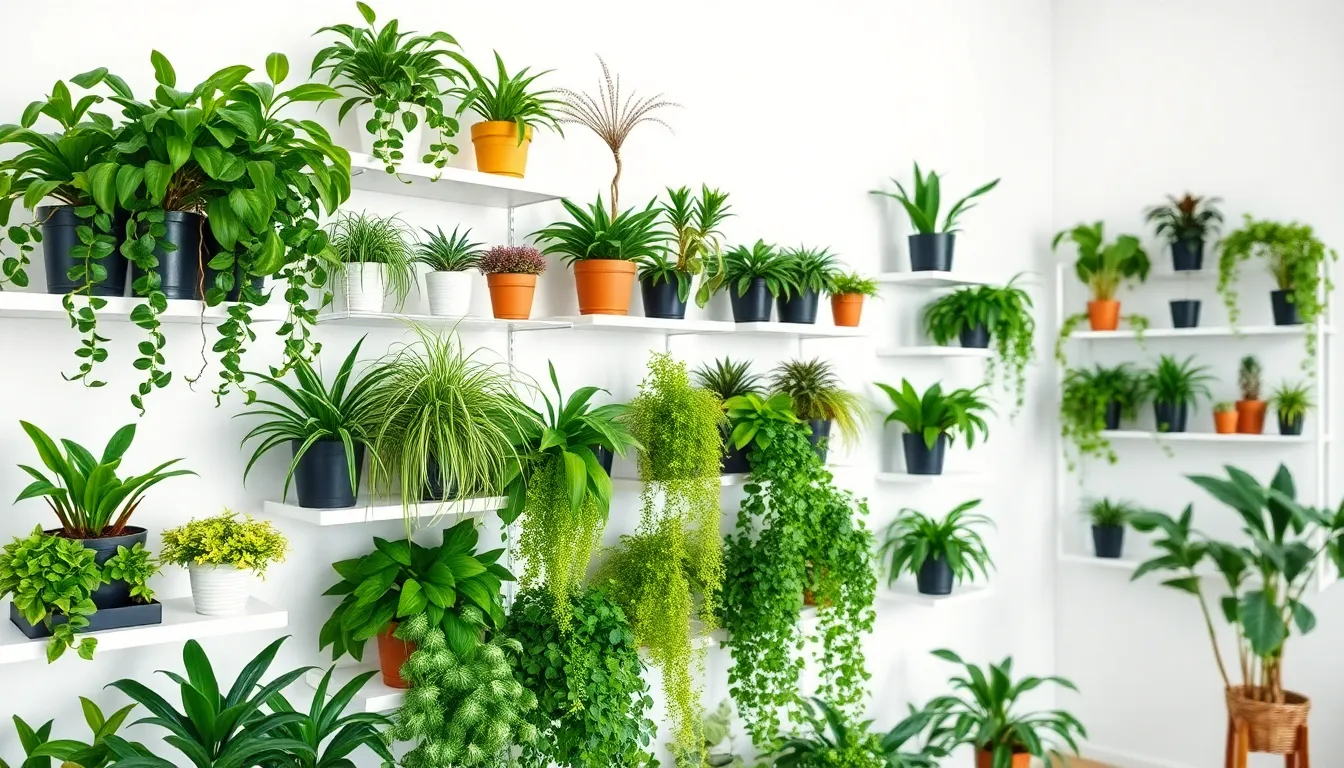
Even the most thoughtfully designed plant gallery walls can encounter challenges that threaten their beauty and health. Successfully addressing these common issues ensures our living wall displays continue to thrive and enhance our spaces.
Address Overwatering and Drainage Issues
Overwatering ranks as the most frequent problem we encounter when maintaining gallery wall plants, often leading to devastating root rot and plant decline. Preventing water accumulation requires containers or shelves equipped with proper drainage holes, plus a strategic drainage layer of pebbles or gravel beneath the soil.
Compatible plant groupings make watering management significantly easier since plants with similar moisture needs prevent inconsistent watering across our display. Monitoring soil moisture regularly helps us determine when each plant actually needs water rather than following a rigid schedule.
Individual plant watering allows us to tailor care to each specimen’s exact requirements, while trailing pothos and philodendrons provide visible signals when they need moisture. These forgiving varieties clearly communicate their water needs through subtle leaf changes, making them ideal choices for gallery wall displays.
Manage Pest Control in Indoor Plant Displays
Indoor plant displays on gallery walls can attract unwanted visitors like spider mites or aphids that threaten our carefully curated arrangements. Regular leaf inspections help us catch pest infestations early before they spread throughout our entire display.
Gentle leaf cleaning with a damp cloth removes dust and potential pest eggs while keeping our plants looking their best. Insecticidal soap applications provide effective treatment when we do discover pest problems without harming our plants or indoor air quality.
Air circulation around our gallery wall discourages pest establishment by creating an environment they find less hospitable. Quarantining new plants before integration prevents introducing pests to our existing healthy display, protecting our investment in time and plant selection.
Replace Struggling Plants Without Disrupting the Design
Plant replacement becomes necessary when specimens fail to thrive even though our best care efforts, but strategic planning prevents design disruption. Selecting replacement plants similar in size and color maintains the visual balance we’ve worked to achieve in our gallery wall composition.
Modular shelving systems and easily accessible pots help quick plant swaps without disturbing neighboring specimens or artwork. Propagating easy-to-root plants like pothos or scindapsus creates identical replacements that seamlessly fill gaps with clones from our existing wall.
Theme consistency about plant types and care requirements ensures new additions integrate smoothly into our established display. Planning ahead with backup plants or propagated specimens ready for installation minimizes the time our gallery wall spends with empty spaces or struggling plants.
Conclusion
Creating a gallery wall with plants transforms any space into a living work of art that evolves with time. We’ve shown you how thoughtful planning and proper maintenance can turn your walls into thriving displays that combine natural beauty with personal style.
The key to success lies in understanding your space’s unique conditions and choosing plants that’ll flourish in your environment. Whether you’re designing a calming bedroom retreat or an energetic living room focal point your plant gallery wall will become a conversation starter that reflects your creativity.
Remember that this design approach isn’t just about aesthetics—it’s about bringing life and vitality into your home. With the right techniques and regular care your gallery wall will continue to grow and change creating an ever-evolving masterpiece that brings joy for years to come.
Frequently Asked Questions
What is a plant gallery wall?
A plant gallery wall is an innovative design trend that combines live plants with framed artwork on a single wall display. This approach incorporates greenery through trailing plants, sculptural succulents, and various other plant types alongside traditional art pieces to create a living, dynamic wall arrangement that adds depth, texture, and natural beauty to any space.
Which plants work best for gallery walls?
Low-light tolerant plants like pothos, philodendrons, and snake plants are ideal for gallery walls. Trailing varieties such as pothos create beautiful cascading effects, while sculptural succulents add interesting shapes. For maintenance-free options, consider preserved moss or dried botanical elements that require no watering or special care.
How do I choose the right wall location?
Assess your wall’s natural light conditions first. South-facing walls suit sun-loving plants, while north-facing walls work better for low-light varieties. Consider seasonal light changes, wall size for proper spacing, and proximity to furniture for easy plant care. Ensure adequate air circulation and stable temperature conditions for plant health.
What hanging systems should I use for plants?
Use picture hanging rails and sturdy wall anchors that can support plant weight. Install brackets directly into wall studs or use heavy-duty anchors for drywall. Choose adjustable hanging hardware for flexibility as plants grow. Distribute weight evenly across multiple hanging points to prevent system failure and wall damage.
How do I design an effective layout?
Plan your layout using symmetrical arrangements for a calming effect or asymmetrical designs following the rule of thirds for dynamic visual interest. Mix trailing and upright plant forms, incorporate floating shelves for varying heights, and leave space for plant growth. Balance plants with framed art and decorative elements for cohesive design.
Can I customize gallery walls for different rooms?
Yes, customize based on each room’s needs. Bedrooms benefit from relaxing plants like pothos with botanical prints. Living rooms can feature vibrant, diverse plant displays with floating shelves. Kitchens work well with functional herb walls using vertical gardens and repurposed containers for culinary plants in well-lit areas.
How do I maintain a plant gallery wall?
Establish a regular watering schedule based on each plant’s needs. Monitor plant health daily, prune regularly, and rotate plants for even light exposure. Fertilize during growing seasons and watch for pest issues. Replace struggling plants with similar-sized alternatives to maintain the overall design aesthetic.
What are common problems and solutions?
Overwatering is the most common issue – ensure proper drainage and group plants with similar water needs. Prevent pests through regular leaf cleaning and inspections. Address root rot by improving drainage and air circulation. When plants struggle, replace them quickly with similar varieties to maintain the wall’s visual balance.

